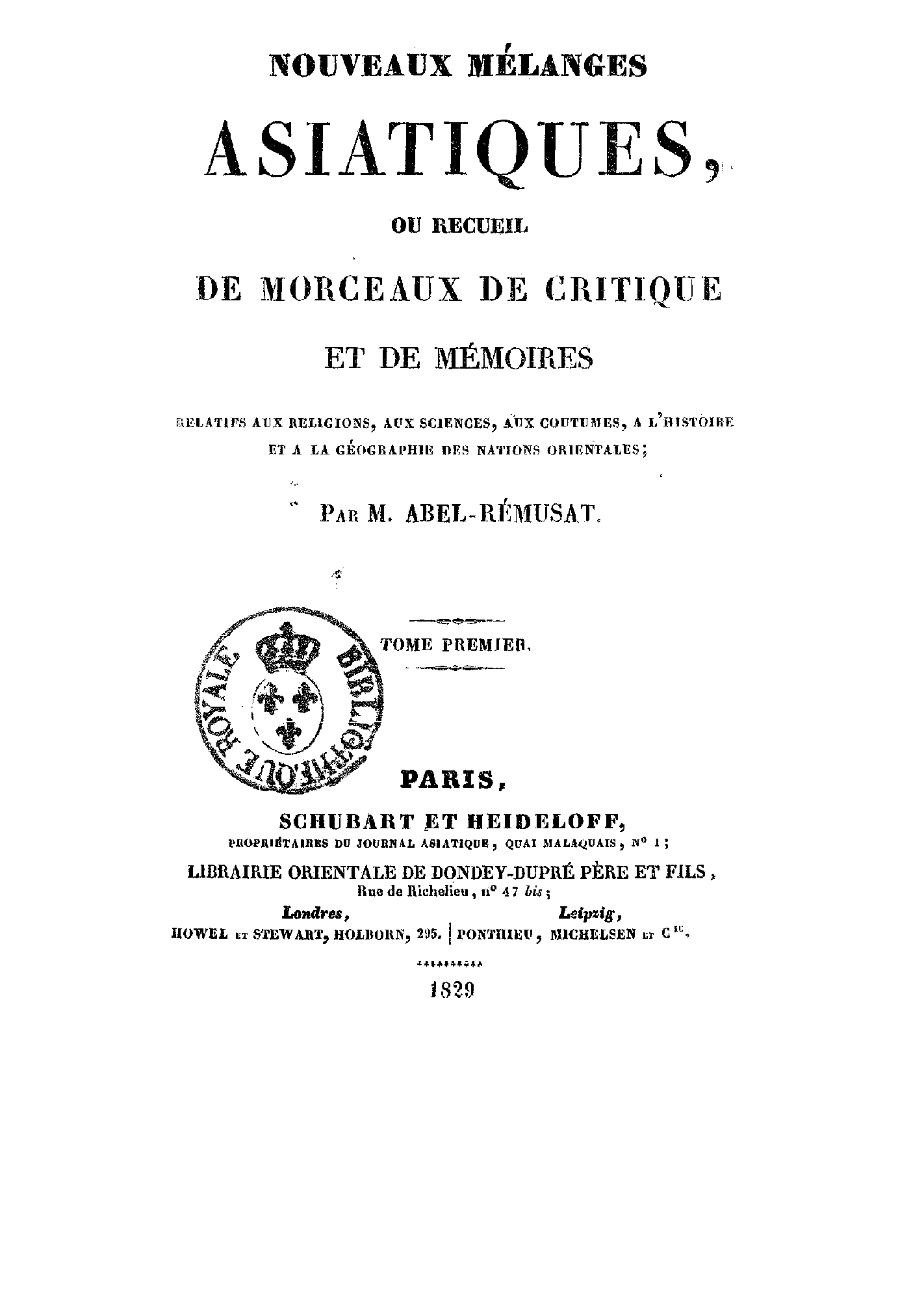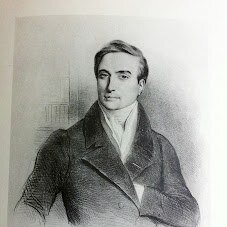Published several decades before the ‘rediscovery’ of Angkor, this collection of Asian studies gives a remarkable glimpse on ‘Tchin-la’ (Chenla, Zhenla, Cambodia), since the Description of Camboge comes as the second chapter of its first volume, right after Coup d’oeil sur la Chine et ses habitants [A Glimpse of China and Its Inhabitants].
It also opened the path to further exploration of Chinese sources on Cambodia, in particular Paul Pelliot’s first real translation into an European language of Zhou Daguan’s Customs of Cambodia.
Sources
- Among his “most valuable sources”, the author mentions L’Introduction à la connaissance des peuples qui ont été soumis a l’Empire de la Chine, par le P. Amiot, in Mémoires des missionnaires de Péking , tome XIV”. However, he points to several errors made by the French Jesuit missionary in his interpretation of Chinese sources, “au milieu de régions qui lui sont inconnues, et j’admire la sagacité de M. Marsden, qui, malgré l’erreur d’ Amiot, n’a pas laissé de reconnaître Cambodge dans le Tchin-la des Chinois (Travels of Marco Polo, p 586)”. […among these lands unknown to him, and I commend the perspicacity of Mr. Marsden who, in spite of Amiot’s mistake, was prompt to recognize Cambodia (Kamboja) in the ‘Tchin-la’ of the Chinese authors] (1)
- The author never mentions Zhou Daguan by name, only introducing him as “un officier chinois qui eut, vers la fin du XIII eme siecle, a remplir une mission diplomatique dans cette contrée.” [a Chinese official who undertook a diplomatic mission to these lands around the end of the 13th century]. Noting that this ‘official’ visited Cambodia in 1295, “the same year Marc-Pol (Marco-Polo) went back to Europe”, he contends that “they probably met and had the same motives to visit the lands south of China”. He mixes Zhou Daguan’s relation with other Chinese documents.
- Prudery and History: “J’ai cependant été contraint de faire quelques suppressions exigées par la bizarrerie des moeurs des Cambogiens et par la naïveté des récits des Chinois qui les décrivent”, [‘I have been forced to delete certain parts due to the oddities of the mores of the Cambodian people, and to the naivety of Chinese chronlclers in describing them.’] notes quite cryptically the author. This certainly refers to the sexual life and the status of women in ancient Cambodia, a topic on which the Chinese visitors commented with astonishment (and veiled admiration). For instance, the author refrains to translate the Chinese detailes notations, limiting himself to: “Les femmes de ce pays sont tres lascives” {the women of this country are extremely lascivious”.
(1) Marco Polo refers to the Kingdom of Ziamba, from which he sailed to Java, in his Travels (Book III, Chap. VI). Ziamba (Latin), Cianban (Old Italian) was identified as Tchampa or Ciampa by Marsden “at the southeastern part of what may be termed the presqu’ile of Kamboja’. Marsden also identified Tchin-la (Chenla, Zhenla) as Kamboja or Cambodia. In his revision of Marsden’s translation (1854), Thomas Wright adds that important notations about the relations between Champa, Kamboja and Majapahit (Javanese Empire in existence from 1293 to circa 1527) can be found in “Sir T. Stamford Raffles’ excellent history of that interesting island.”
Description of Tchin-la (Chenla, Zhenla)
From Zhou Daguan “translated” by Abel-Rémusat, we shall retain the following observations:
- The Chinese view on ‘vassal lands: ‘La douzième année Taï-nie ( 616) du règne de
Yang-ti de la dynastie des Souï, à la seconde lune, le pays de Tchin-la commença à payer le tribut, et à envoyer des ambassadeurs.’ Later on, other tributes, gifts sending to the Chinese Emperor, and exchanges of diplomatic legations are mentioned, from other Chinese sources since they date almost one century after Zhou Daguan’s visit to Angkor. - Women: While noting that ‘debauchery’ (wine drinking) occurs only inside the house, between husband and wife, the author remarks: “Quand un particuJier a de belles filles, on les fait entrer dans le palais; il y en a dans le nombre qui vont et viennent parce qu’elles sont employées au service; elles sont appelées Tchin-kia-lan (2), et l’on n’en compte pas moins d’un à deux mille; il y en a parmi elles qui ont leurs maris, et qui habitent confondues avec les autres personnes de la ville; elles né se distinguent que parce qu’elles se rasent les cheveux aux deux côtés des joues, et se peignent avec du cinabre les joues ainsï, que les tempes; c’est là le signe distinctif des Tchin-kia-lan. Il n’y a que ces femmes qui aient le droit d’entrer dans le palais; les autres n’y sont pas admises.”
- Sexuality 1: Leaving aside his proverbial prudishness, the author seems as much fascinated as the Chinese sources with the rite of sexual initiation (deflowering) for young girls: “Une fille riche se marie generalement entre sept et neuf ans. Celles qui sont très pauvres attendent quelquefois jusqu’à onze ans. On né manqué pas de charger un prêtre de Bouddha ou un tao-sse de leur enlever leur virginité. Cette fonction se nomme tchin-than (3)”. For the latter term, he only gives a quite cryptic Latin translation, Strati dipositio (arrangement of the bed?).
- Sexuality 2: He also alludes to the ubiquity of ‘hommes de mauvaise vie (Cinaedi, le terme chinois signifie hermaphrodite)’ [‘debauchers, with the Latin plural for cinaedus, ‘sodomite, effeminate’, the Chinese term meaning hermaphrodite’] who ‘roam public places and invite Chinese people to visit houses’ where, according to what he retains from the Chinese version, ‘la chère est très mauvaise’ [‘the food is ghastly’]. (4)
- East and West orientation: In Chenla, doors are erected always facing West, notes the the most revered orientation, notes the author quoting Chinese sources. This is an important notation when applied to Angkor Wat, since modern scholars have often attributed the West orientation of this major temple (contrary to all other major Khmer or Indian temples) to funerary symbolism.
- Trade and commercial exchanges: “Ce pays né produit ni or ni argent; car l’or et l’argent de la Chine sont la marchandise que les Cambogiens mettent au premier rang. Ce qu’ils estiment le plus ensuite, c’est l’étoffe tissue en soie torse, de différentes couleurs; ils mettent après l’étain de Tchin-tcheou, les coffres vernis de Wen-tcheou (2), les vases de porcelaine bleue de Thsiouan-tcheou ; le vif-argent, le cinabre, du papier, du soufre, du salpêtre, du santal, du pe-tchi, du musc, de la toile de chanvre, de la toile de hoang-thsao, des parapluies, des marmites de fer, des vases de cuivre, du moutclm, de l’huile de l’arbre appelé thoung (Bignonia tormentosa), des cribles, des peignes de bois, des aiguilles ; ils estiment aussi les nattes comme celles de Ming-tcheou ; néanmoins ce qu’ils souhaitent par-dessus tout, c’est du blé, mais l’exportation n’en est pas permise.”
- Traditional medicine: “On trouve dans les marchés des remedes qui né ressemblent en rien à ceux de la Chine; je né sais avec quoi ils sont préparés. Il y a aussi des especes d’enchanteurs qui se mêlent de guérir les malades, et dont les procédés sont extrêmement ridicules.” [The medicines found in the markets have nothing in common with what is in use in China, I don’t know how they are prepared. There are also some sort of magicians who pretend they can cure sick people, and whose techniques are completely ridiculous.]
- Linguistics: “Un se dit meï, Deux, pieï, Trois, pi, Quatre, pan, Cinq, phou-kian, Six, phou-kian-meï, Sept, phou-kian-pieï, Huit, phou-kian-peï, Neuf, phou-kian-pan…” [One is mei in Khmer, two…, etc]
(1) In his English translation of Marco Polo’s Travels, Marsden was in effect the first Western scholar to ascertain that the Latin Zambia (Old Italian Cianba) was Champa, and that Tchin-la (Chenla, Zhenla) was in fact Camboja, accessible by sea and not only from Siam (Thailand).
(2) According to the latest translation of Zhou Daguan’s relation so far, this term is a Chinese transcription of a Khmer word that remains unidentified. In his translation, Peter Harris notes that “Chenjialan 陳家蘭 [P tshinkjalan, K d’ienkalan] has not been satisfactorily explained. It has been identified with several possible words in Cambodian and Sanskrit, including the Sanskrit srngara, meaning adornment, sexual passion.”
(3) the Chinese word is Zhentan 陣毯 [P tsintham], according to Peter Harris (op. cit.) “probably from a Khmer word, but if so the word has not been identified. The ritual described in this chapter is also described in another Yuan dynasty compendium of Chinese travel writings, Yi yu ji 異域志, Treatise on Strange Frontier Lands, by Zhou Zhizhong.”
(4) Er xing ren 二形人, “intersex people”, according to Peter Harris (op.cit.) a term that “has been taken to refer to gay men, but means literally “people with two forms or appearances” and could describe epicene or transgender qualities rather than homosexuality as such.”
(5) Wenzhou, Zhou Daguan’s native city, an important Chinese port and commercial hub.



